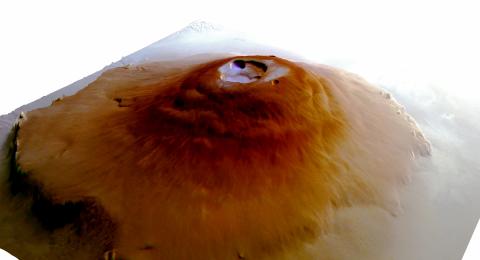Mineral in Martian dust changes explanation for why Mars is red and hints at primitive conditions
The red colour of Mars corresponds to a type of ferrihydrite that is the dominant form of iron oxide in Martian dust, although previous studies have attributed it to anhydrous haematite. The persistence of ferrihydrite, whose formation requires water, suggests that it formed during a cold, wet period, followed by a transition to the planet's current arid environment. The result, based on ESA and NASA space data and new laboratory experiments, is published in Nature Communications.

César Menor - Marte rojo EN
César Menor Salván
Astrobiologist and lecturer of Biochemistry at the University of Alcalá
The manuscript lacks figures, so I cannot comment on it in more detail. What they tell is very interesting: it is the identification of the presence of ferrihydrite as an important iron mineral on Mars. This gives very important clues about the environmental conditions on early Mars.
Ferrihydrite is very common and can be seen, along with other phases, in any iron material that oxidises, as well as being very common in soils and sediments of rivers or lakes, where it is formed by bacterial activity. Even we generate ferrihydrite, as it is one of the forms in which we store iron: small crystals of ferrihydrite associated with the protein ferritin.
For ferrihydrite to form, you need an oxidising environment and water, which helps to understand the early environment on Mars. Interestingly, ferrihydrite is not stable, and transforms into other minerals, such as haematite or goethite. The preservation of ferrihydrite on Mars also confirms the environmental evolution of the planet: early Mars underwent a transition to today's extremely arid conditions. This surprises me the most, because ferrihydrite is a mineral that forms under very active conditions on Earth. The fact that it has been preserved suggests that Mars was, shall we say, ‘frozen’.
It should be noted that the detection is based on observations from Mars missions and comparison of the data with a series of experiments on the synthesis of ferrihydrite and other minerals, and simulation of the dust on the Martian surface. This finding would need to be confirmed in the future by direct analysis of the mineral.
Jesús Martínez Frías - Marte rojo EN
Jesús Martínez Frías
Planetary geologist and astrobiologist at the IGEO (CSIC-UCM). Academician of the Royal Academies of Sciences and Doctors of Spain. President of the Planetary Geology Commission of the Geological Society of Spain and of the Spanish Network of Planetology and Astrobiology.
It is a very interesting study that connects mineralogy with other aspects related to Martian habitability. It does so by combining different techniques from in-orbit instruments, in situ (field analysis) and also with laboratory materials. The conclusions are therefore based on solid methodologies that address the objectives very well.
The first published studies linking ferrihydrite to Mars date back to the 1990s (e.g. Robbins et al. 1991, Bishop et al. 1993). Although the presence of this mineral and other [ferro] oxides and water-related mineral phases (sulphates such as jarosite, gypsum, etc.) has subsequently been raised by numerous investigations, probably the first study that experimentally confirmed the presence of ferrihydrite on Mars was by the Mars Exploration Rover (MER) in the Meridiani area (Farrand et al. 2007). Since that year, many other works have addressed the relevance of iron oxides, along with that of other mineral ores, with different objectives, including the characterisation of Martian palaeoenvironments and their habitability conditions.
The main novelties of this research focus on the set of methodologies from different sources and on the importance of water, whose imprint has been captured in the hydrated iron oxides (ferrihydrite) of Martian dust and other mineral phases also related to water, as opposed to the more anhydrous nature, which was classically assumed.
Until we have well-selected and sampled minerals, rocks and regolith on Mars, such as those brought to Earth by a mission like the Mars Sample Return, and experiments that allow us to drill into the surface, such as those that the Rosalind Franklin rover intends to perform, we will not be able to carry out detailed experimentation (including well-defined isotopic studies) and an assessment of the transformations, cycles and sequences of processes and environments over the billions of years of Mars' geological evolution. For the moment, we only have the Martian meteorites and the characterisations that we can carry out with orbiters, rovers and experimental laboratory simulations (including terrestrial analogues as natural laboratories). Nevertheless, this study is an important step forward and a further step in understanding the complex puzzle of Martian geology and mineralogy.
Adomas Valantinas et al.
- Research article
- Peer reviewed



